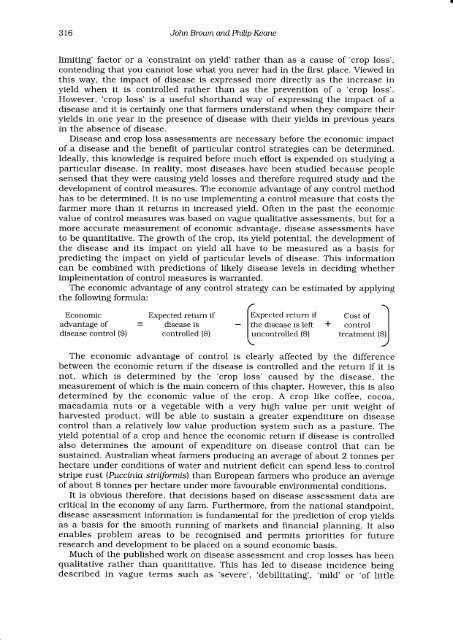Assessment of disease and effects on yield - Australasian Plant ...
Assessment of disease and effects on yield - Australasian Plant ...
Assessment of disease and effects on yield - Australasian Plant ...
Create successful ePaper yourself
Turn your PDF publications into a flip-book with our unique Google optimized e-Paper software.
316 John Brotun <str<strong>on</strong>g>and</str<strong>on</strong>g> Philip Keane<br />
limiting' factor or a 'c<strong>on</strong>straint <strong>on</strong> <strong>yield</strong>' rather than as a cause <str<strong>on</strong>g>of</str<strong>on</strong>g> 'crop loss',<br />
c<strong>on</strong>tending that you cannot lose what you never had in the first place. Viewed in<br />
this way, the impact <str<strong>on</strong>g>of</str<strong>on</strong>g> <str<strong>on</strong>g>disease</str<strong>on</strong>g> is expressed more directly as the increase in<br />
<strong>yield</strong> when it is c<strong>on</strong>trolled rather than as the preventi<strong>on</strong> <str<strong>on</strong>g>of</str<strong>on</strong>g> a 'crop loss'.<br />
However, 'crop loss' is a useful shorth<str<strong>on</strong>g>and</str<strong>on</strong>g> way <str<strong>on</strong>g>of</str<strong>on</strong>g> expressing the impact <str<strong>on</strong>g>of</str<strong>on</strong>g> a<br />
<str<strong>on</strong>g>disease</str<strong>on</strong>g> <str<strong>on</strong>g>and</str<strong>on</strong>g> it is certainly <strong>on</strong>e that farmers underst<str<strong>on</strong>g>and</str<strong>on</strong>g> when they compare their<br />
<strong>yield</strong>s in <strong>on</strong>e year in the presence <str<strong>on</strong>g>of</str<strong>on</strong>g> <str<strong>on</strong>g>disease</str<strong>on</strong>g> with their <strong>yield</strong>s in previous years<br />
in the absence <str<strong>on</strong>g>of</str<strong>on</strong>g> <str<strong>on</strong>g>disease</str<strong>on</strong>g>.<br />
Disease <str<strong>on</strong>g>and</str<strong>on</strong>g> crop loss assessments are necessary before the ec<strong>on</strong>omic impact<br />
<str<strong>on</strong>g>of</str<strong>on</strong>g> a <str<strong>on</strong>g>disease</str<strong>on</strong>g> <str<strong>on</strong>g>and</str<strong>on</strong>g> the benefit <str<strong>on</strong>g>of</str<strong>on</strong>g> particular c<strong>on</strong>trol strategies can be determined.<br />
Ideally, this knowledge is required before much effort is expended <strong>on</strong> studying a<br />
particular <str<strong>on</strong>g>disease</str<strong>on</strong>g>. In reality, most <str<strong>on</strong>g>disease</str<strong>on</strong>g>s have been studied because people<br />
sensed that they were causing <strong>yield</strong> losses <str<strong>on</strong>g>and</str<strong>on</strong>g> therefore required study <str<strong>on</strong>g>and</str<strong>on</strong>g> the<br />
development <str<strong>on</strong>g>of</str<strong>on</strong>g> c<strong>on</strong>trol measures. The ec<strong>on</strong>omic advantage <str<strong>on</strong>g>of</str<strong>on</strong>g> any c<strong>on</strong>trol method<br />
has to be determined. It is no use implementing a c<strong>on</strong>trol measure that costs the<br />
farmer more than it returns in increased <strong>yield</strong>. Often in the past the ec<strong>on</strong>omic<br />
value <str<strong>on</strong>g>of</str<strong>on</strong>g> c<strong>on</strong>trol measures was based <strong>on</strong> vague qualitative assessments, but for a<br />
more accurate measurement <str<strong>on</strong>g>of</str<strong>on</strong>g> ec<strong>on</strong>omic advantage, <str<strong>on</strong>g>disease</str<strong>on</strong>g> assessments have<br />
to be quantitative. The growth <str<strong>on</strong>g>of</str<strong>on</strong>g> the crop, its <strong>yield</strong> potential, the development <str<strong>on</strong>g>of</str<strong>on</strong>g><br />
the <str<strong>on</strong>g>disease</str<strong>on</strong>g> <str<strong>on</strong>g>and</str<strong>on</strong>g> its impact <strong>on</strong> <strong>yield</strong> all have to be measured as a basis for<br />
predicting the impact <strong>on</strong> <strong>yield</strong> <str<strong>on</strong>g>of</str<strong>on</strong>g> particular levels <str<strong>on</strong>g>of</str<strong>on</strong>g> <str<strong>on</strong>g>disease</str<strong>on</strong>g>. This informati<strong>on</strong><br />
can be combined with predicti<strong>on</strong>s <str<strong>on</strong>g>of</str<strong>on</strong>g> likely <str<strong>on</strong>g>disease</str<strong>on</strong>g> levels in deciding whether<br />
implementati<strong>on</strong> <str<strong>on</strong>g>of</str<strong>on</strong>g> c<strong>on</strong>trol measures is warranted.<br />
The ec<strong>on</strong>omic advantage <str<strong>on</strong>g>of</str<strong>on</strong>g> any c<strong>on</strong>trol strategy can be estimated by applying<br />
the following formula:<br />
r \<br />
Ec<strong>on</strong>omic Expected return if lExpected return if Cost <str<strong>on</strong>g>of</str<strong>on</strong>g> I<br />
advantage <str<strong>on</strong>g>of</str<strong>on</strong>g> = <str<strong>on</strong>g>disease</str<strong>on</strong>g> is lthe <str<strong>on</strong>g>disease</str<strong>on</strong>g> is left + c<strong>on</strong>trol I<br />
<str<strong>on</strong>g>disease</str<strong>on</strong>g> c<strong>on</strong>trol ($) c<strong>on</strong>trolled ($) | unc<strong>on</strong>trolled ($) treatment ($)l<br />
\ - )<br />
The ec<strong>on</strong>omic advantage <str<strong>on</strong>g>of</str<strong>on</strong>g> c<strong>on</strong>trol is clearly affected by the difference<br />
between the ec<strong>on</strong>omic return if the <str<strong>on</strong>g>disease</str<strong>on</strong>g> is c<strong>on</strong>trolled <str<strong>on</strong>g>and</str<strong>on</strong>g> the return if it is<br />
not, which is determined by the 'crop loss' caused by the <str<strong>on</strong>g>disease</str<strong>on</strong>g>, the<br />
measurement <str<strong>on</strong>g>of</str<strong>on</strong>g> which is the main c<strong>on</strong>cerrr <str<strong>on</strong>g>of</str<strong>on</strong>g> this chapter. However, this is also<br />
determined by the ec<strong>on</strong>omic value <str<strong>on</strong>g>of</str<strong>on</strong>g> the crop. A crop like c<str<strong>on</strong>g>of</str<strong>on</strong>g>fee, cocoa,<br />
macadamia nuts or a vegetable with a very high value per unit weight <str<strong>on</strong>g>of</str<strong>on</strong>g><br />
harvested product, will be able to sustain a greater expenditure <strong>on</strong> <str<strong>on</strong>g>disease</str<strong>on</strong>g><br />
c<strong>on</strong>trol than a relatively low value producti<strong>on</strong> system such as a pasture. The<br />
<strong>yield</strong> potential <str<strong>on</strong>g>of</str<strong>on</strong>g> a crop <str<strong>on</strong>g>and</str<strong>on</strong>g> hence the ec<strong>on</strong>omic return if <str<strong>on</strong>g>disease</str<strong>on</strong>g> is c<strong>on</strong>trolled<br />
also determines the amount <str<strong>on</strong>g>of</str<strong>on</strong>g> expenditure <strong>on</strong> <str<strong>on</strong>g>disease</str<strong>on</strong>g> c<strong>on</strong>trol that can be<br />
sustained. Australian wheat farmers producing an average <str<strong>on</strong>g>of</str<strong>on</strong>g> about 2 t<strong>on</strong>nes per<br />
hectare under c<strong>on</strong>diti<strong>on</strong>s <str<strong>on</strong>g>of</str<strong>on</strong>g> water <str<strong>on</strong>g>and</str<strong>on</strong>g> nutrient deficit can spend less to c<strong>on</strong>trol<br />
stripe rust (Puccinta striif,ornis) than European farmers who produce an average<br />
<str<strong>on</strong>g>of</str<strong>on</strong>g> about B t<strong>on</strong>nes per hectare under more favourable envir<strong>on</strong>mental c<strong>on</strong>diti<strong>on</strong>s.<br />
It is obvious therefore, that decisi<strong>on</strong>s based <strong>on</strong> <str<strong>on</strong>g>disease</str<strong>on</strong>g> assessment data are<br />
critical in the ec<strong>on</strong>omy <str<strong>on</strong>g>of</str<strong>on</strong>g> any farm. Furthermore, from the nati<strong>on</strong>al st<str<strong>on</strong>g>and</str<strong>on</strong>g>point,<br />
<str<strong>on</strong>g>disease</str<strong>on</strong>g> assessment informati<strong>on</strong> is fundamental for the predicti<strong>on</strong> <str<strong>on</strong>g>of</str<strong>on</strong>g> crop <strong>yield</strong>s<br />
as a basis for the smooth running <str<strong>on</strong>g>of</str<strong>on</strong>g> markets <str<strong>on</strong>g>and</str<strong>on</strong>g> financial planning. It also<br />
enables problem areas to be recognised <str<strong>on</strong>g>and</str<strong>on</strong>g> permits priorities for future<br />
research <str<strong>on</strong>g>and</str<strong>on</strong>g> development to be placed <strong>on</strong> a sound ec<strong>on</strong>omic basis.<br />
Much <str<strong>on</strong>g>of</str<strong>on</strong>g> the published work <strong>on</strong> <str<strong>on</strong>g>disease</str<strong>on</strong>g> assessment <str<strong>on</strong>g>and</str<strong>on</strong>g> crop losses has been<br />
qualitative rather than quantitative. This has led to <str<strong>on</strong>g>disease</str<strong>on</strong>g> incidence being<br />
described in vague terms such as 'severe', 'debilitating', 'mild' or '<str<strong>on</strong>g>of</str<strong>on</strong>g> little







![[Compatibility Mode].pdf](https://img.yumpu.com/27318716/1/190x135/compatibility-modepdf.jpg?quality=85)









